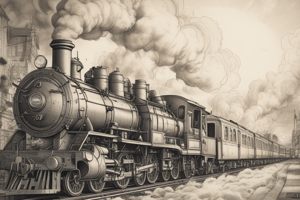Podcast
Questions and Answers
What occurs at the critical point of a substance?
What occurs at the critical point of a substance?
- The distinction between liquid and gas phases disappears. (correct)
- The substance can only exist in a gas phase.
- The liquid and gas phases separate into distinct phases.
- The substance can only exist in a liquid phase.
What is the characteristic of the critical point in terms of phase transition?
What is the characteristic of the critical point in terms of phase transition?
- There is no distinct phase transition. (correct)
- The phase transition only occurs at low pressures.
- There is a sudden and abrupt change from liquid to gas.
- The phase transition only occurs at high temperatures.
What is the term for the amount of heat required to change the temperature of a substance without changing its phase?
What is the term for the amount of heat required to change the temperature of a substance without changing its phase?
- Superheat
- Sensible heat (correct)
- Total heat
- Latent heat
What is the term for the energy required to overcome the pressure-volume work done during a process?
What is the term for the energy required to overcome the pressure-volume work done during a process?
What is the term for steam that is heated above its saturation temperature without changing its pressure?
What is the term for steam that is heated above its saturation temperature without changing its pressure?
What is the term for a mixture of steam and water droplets that occurs when steam is not fully superheated?
What is the term for a mixture of steam and water droplets that occurs when steam is not fully superheated?
What is a significant benefit of steam's low viscosity?
What is a significant benefit of steam's low viscosity?
What is the primary reason why steam is an effective sterilizer?
What is the primary reason why steam is an effective sterilizer?
What is the unique combination of temperature and pressure at which a substance coexists in all three phases?
What is the unique combination of temperature and pressure at which a substance coexists in all three phases?
At what temperature and pressure does ice, water, and steam coexist in equilibrium?
At what temperature and pressure does ice, water, and steam coexist in equilibrium?
What happens to steam when it condenses back into liquid water?
What happens to steam when it condenses back into liquid water?
What is the term for the temperature and pressure above which a substance cannot be liquefied, regardless of pressure?
What is the term for the temperature and pressure above which a substance cannot be liquefied, regardless of pressure?
What is the dryness fraction of a steam mixture that consists entirely of water?
What is the dryness fraction of a steam mixture that consists entirely of water?
What is the internal energy of steam a measure of?
What is the internal energy of steam a measure of?
What occurs during the external work of evaporation?
What occurs during the external work of evaporation?
What is the internal latent heat of vaporization?
What is the internal latent heat of vaporization?
What is the relationship between specific volume and density?
What is the relationship between specific volume and density?
What is enthalpy a measure of?
What is enthalpy a measure of?
What does enthalpy represent in the context of steam?
What does enthalpy represent in the context of steam?
What is the primary difference between internal energy and enthalpy?
What is the primary difference between internal energy and enthalpy?
What happens to the entropy of a system when it undergoes a phase change from liquid to vapor?
What happens to the entropy of a system when it undergoes a phase change from liquid to vapor?
What is the quality of a two-phase liquid-vapor mixture?
What is the quality of a two-phase liquid-vapor mixture?
What is the significance of the saturation temperature for water at 1.014 bar?
What is the significance of the saturation temperature for water at 1.014 bar?
What is the purpose of an enthalpy-entropy chart?
What is the purpose of an enthalpy-entropy chart?
What does the enthalpy-pressure chart typically represent?
What does the enthalpy-pressure chart typically represent?
What is the significance of the critical point in a saturated phase?
What is the significance of the critical point in a saturated phase?
What is the purpose of the barrel calorimeter?
What is the purpose of the barrel calorimeter?
What is the characteristic of a saturated liquid or vapour?
What is the characteristic of a saturated liquid or vapour?
What is the advantage of using a barrel calorimeter?
What is the advantage of using a barrel calorimeter?
What is the significance of the lines of constant dryness fraction in a h-s chart?
What is the significance of the lines of constant dryness fraction in a h-s chart?
In a Separating Calorimeter, what happens to the wet steam when it strikes the perforated cup?
In a Separating Calorimeter, what happens to the wet steam when it strikes the perforated cup?
What is the advantage of using a Separating Calorimeter?
What is the advantage of using a Separating Calorimeter?
What is the purpose of the partially-opened valve in a Throttling Calorimeter?
What is the purpose of the partially-opened valve in a Throttling Calorimeter?
What is the disadvantage of using a Throttling Calorimeter?
What is the disadvantage of using a Throttling Calorimeter?
What is the purpose of the separator in a Combined Separating and Throttling Calorimeter?
What is the purpose of the separator in a Combined Separating and Throttling Calorimeter?
When is a Combined Separating and Throttling Calorimeter used?
When is a Combined Separating and Throttling Calorimeter used?
What is the advantage of using a Throttling Calorimeter?
What is the advantage of using a Throttling Calorimeter?
In a Separating Calorimeter, how is the weight of steam passing through the jacket determined?
In a Separating Calorimeter, how is the weight of steam passing through the jacket determined?
What is the disadvantage of using a Separating Calorimeter?
What is the disadvantage of using a Separating Calorimeter?
What is the result of throttling the steam in a Throttling Calorimeter?
What is the result of throttling the steam in a Throttling Calorimeter?
Flashcards are hidden until you start studying
Study Notes
Properties of Steam
- Steam has a high energy content, which is released as heat when it condenses back into liquid water.
- Steam has a low viscosity, making it easy to flow and penetrate small spaces.
- Steam is much less dense than water, allowing it to expand and rise quickly.
- Steam is an excellent heat transfer medium, making it useful for heating and cooling applications.
- Steam is an effective sterilizer, killing bacteria and other microorganisms at temperatures above 160°C (320°F).
- Steam is a powerful cleaning agent, able to loosen and remove dirt and grime without chemicals.
- Steam expands rapidly when heated, making it useful for power generation and mechanical work.
- Steam condenses back into liquid water when cooled, releasing its heat energy in the process.
Triple Point
- The triple point is the temperature and pressure at which a substance coexists in all three phases: solid, liquid, and gas.
- For water, the triple point is at 0.01°C (32.018°F) and 611.73 pascals (0.0886 atm).
- At this point, ice, water, and steam are in equilibrium.
Critical Point
- The critical point is the temperature and pressure above which a substance cannot be liquefied, regardless of pressure.
- For water, the critical point is at 374°C (680°F) and 22.1 megapascals (220 atm).
- Characteristics of the critical point include:
- No phase boundary between liquid and gas phases.
- Substances display interesting behavior, such as increased compressibility and anomalous phenomena like critical opalescence.
- No distinct phase transition.
Sensible Heat and Latent Heat
- Sensible heat is the amount of heat or energy required to change the temperature of a substance without changing its phase.
- Latent heat is the amount of heat absorbed or released during a phase transition at constant temperature.
- Example: Boiling water, where enough thermal energy is given to water to change its phase from liquid to vapor.
Superheat
- Superheating refers to heating a substance above its saturation temperature without changing its pressure.
- Example: When water is heated and reaches its boiling point at a given pressure, it begins to convert into steam. If more heat is added, the temperature of the steam increases further, resulting in superheated steam.
- Superheated steam carries more energy and can transfer more heat than saturated steam at the same pressure.
Total Heat (Enthalpy)
- Total heat, or enthalpy, is the total energy content of a substance, including both internal energy and the energy required to overcome the pressure-volume work done during the process.
- Enthalpy is calculated using the equation: h = u + Pv, where h is specific enthalpy, u is specific internal energy, P is pressure, and v is specific volume.
Wet Steam and Dryness Fraction (x)
- Wet steam is a mixture of steam and water droplets.
- Dryness fraction, or quality of steam, is the proportion of steam in the wet steam mixture, defined as x = (mass of vapor) / (mass of vapor + mass of water droplets).
- The dryness fraction ranges from 0 (all water) to 1 (all steam).
Internal Energy of Steam (u)
- Internal energy of steam represents the total energy stored in the steam, including both sensible and latent energy.
- Internal energy is calculated using the equation: u = h - pV.
External Work of Evaporation
- External work of evaporation refers to the work done by the expanding steam against the surrounding pressure during the phase change from liquid to vapor at constant temperature.
Internal Latent Heat
- Internal latent heat, or latent heat of vaporization, is the amount of heat energy required to change the phase of a substance from liquid to vapor without a change in temperature.
Specific Volume
- Specific volume is the volume occupied by a unit mass of the substance.
- Specific volume is inversely related to density and decreases as density increases.
Enthalpy
- Enthalpy is a measure of the total energy content of a substance, including both internal energy and the product of pressure and volume.
Internal Energy
- Internal energy represents the sum of all microscopic forms of energy within the substance.
Entropy
- Entropy is a measure of the disorder or randomness of a system.
- Entropy increases with the phase change from liquid to vapor because steam is more disordered than water molecules.
Phase Behaviour
- Phase change of 1 kg of liquid water at constant pressure, with temperature increasing until reaching the saturated liquid state.
- Further heating causes the liquid to evaporate at constant pressure, reaching the saturated vapor state.
- Additional heating increases the temperature and specific volume, resulting in superheated vapor.
Measurement of Steam Quality
- Measurement of steam quality involves determining the dryness fraction (x) using various methods, including calorimetry.
- Types of calorimeters used for measurement of steam quality include barrel calorimeter, separating calorimeter, throttling calorimeter, and combined separating and throttling calorimeter.
Studying That Suits You
Use AI to generate personalized quizzes and flashcards to suit your learning preferences.





